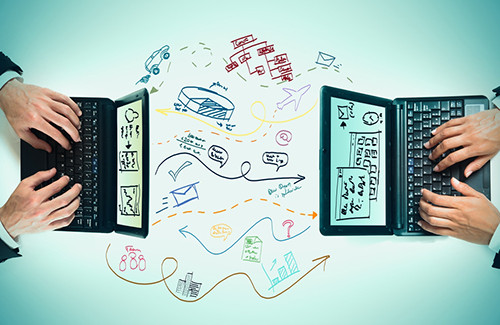Messaging apps, like the most popular Line and WeChat from Asia, have been hugely influential to the rest of the world. Hundreds of millions of people of all ages now use some form of messaging service to contact friends and family and keep in touch about life’s latest happenings. Using these messaging services, users stay connected via text, video and audio calls any time, from any place. With all this real-time human connection, accessibility and immediacy, it’s no wonder that the idea of this form of instant communication is catching on in the business world, and it’s changing everything.
Now, teams, not just teens, are texting and chatting to get serious work done. Instead of waiting on a reply from someone with 150 unread emails just in from their morning commute, colleagues can instantly connect in a chat room to collaborate on project details. Regardless of time zones or travel schedules, people can stay in sync and have accessibility to team members, files, decisions, updates and changes. In less time than it takes to figure out an email subject line, actual work gets done in chat. Work flows like a conversation — more human, friendly and much less stressful. Employees feel more satisfied with their work, more creative and happier.
Overwhelmed by Email
Email is like a bad bento box: disorganized, dysfunctional and unappealing. As businesses expand globally, employees from all generations need to work together with people from different countries, time zones, generations, cultures and languages — all in a rapidly changing, complex business environment. Today, we must be able to connect on a universal level — more visually, more collaboratively and in a more humanistic way. There’s no empathy in an email experience.
Why should a chat-based system offer so much more satisfaction than an email-based system? Think about the 150 emails referenced earlier. This volume alone is stress-inducing, but worse is the fact that there is often no clear way to identify which emails are associated with which projects. That makes it necessary to open and read each email, which may take an hour or more. As a result, workers often feel as if they’re falling behind in their work before the day has even begun.
Additionally, work slows down because team members are waiting for a response before they can proceed with a particular part of a project. This slows down the entire process and leads to frustration. When a colleague does eventually respond with an answer or file, it can be lost in the shuffle among the scads of additional, unrelated emails that have arrived during the wait.
Adding to this disruptive pattern are the many time-consuming meetings that might occur throughout the day. Typically, meetings are scheduled at the convenience of a few senior team members, interrupting the workflow of everyone else.
Together, these factors chip away at the camaraderie of teamwork. Between too many meetings, onslaught of emails, disparate project management and communication platforms, things start falling through the cracks, productivity drops, tensions and frustrations rise.
Why Messaging Apps are More Efficient
While a chat-based collaboration platform cannot fix all these problems, it can help. Chat apps typically divide users into rooms that can be organized by projects, teams or topics. Each room is accessible to designated members and information is exchanged in a transparent, secure environment. Team members are aligned and working toward the same goal. Colleagues, whether in the same office or across the ocean, know who’s working on what and who’s responsible for which aspects of the project. Participants know the strengths of each team member and how they can leverage those strengths. Given the friendly culture of chat enlivened with emojis, each worker’s contributions are clear with a positive tone. Collaboration feels like the true, human connection of teamwork.
It’s also helpful that chats are expected to be brief, so the overwhelming clogged inbox is replaced by a quick scan of chats related to each project. At a glance, anyone can see and respond to important chats. The hours spent scanning and interpreting emotionally ambiguous email can now be used to just get work done.
Simpler, Friendlier, More Human
The power of these chat-based platforms is in their simplicity. Everyone is focused on accomplishing tasks toward a common goal. Communication, often mobile, is limited to brief, friendly updates, punctuated with emojis, which serve as a proxy for human facial expression. Research has shown that while their use in the workplace is still unorthodox, emoticons and emoji reflect the friendliness of the sender and may reduce negative interpretations. The overall tone of chat tends to be concise, but also warm and friendly, in contrast to toneless email. In a chat group, all team members are on equal footing. Unlike meetings, introverts can contribute right alongside more dominant personalities. Giving everyone the opportunity to contribute and have a voice creates a deeper level of employee engagement. Everyone pulls together toward a common goal.
As an organization, companies that switch to chat-based communication may find dramatic improvements in productivity, employee satisfaction and retention. Some traditional companies may at first question this new method of communication, but with time will see the value, time savings and increase business results. The stage is poised for broad and rapid adoption.
The wave of messaging apps that has already consumed Asia is heading west, and the U.S. will see more chat-based communications used by businesses to increase productivity without churn. While this won’t mean the death of email, it will likely mean the rise of a friendlier, more collaborative way to work.






